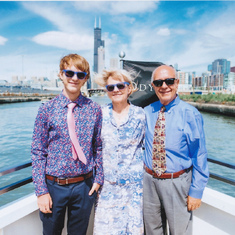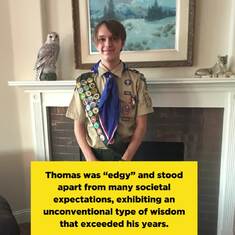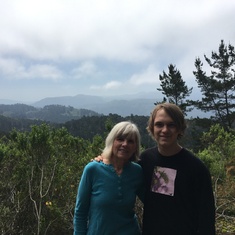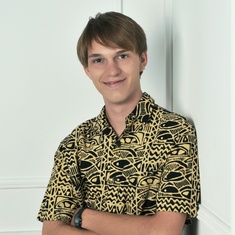What Happened to Thomas
January 5
Thomas came home from working at Kohl’s department store at 9:10 pm on Saturday, May 1, 2021. Elin and I chatted with him about how things went at work and how he was doing in general, and then he went to his room. That was the last time we saw our son alive. Thomas went to his room and took what he thought was a prescription Xanax pill that he bought on Snap Chat for fifteen dollars. He was trying to relax, calm his stress, anxiety and play some video games after work. About 9:30 PM he ordered some food from Door Dash, but he never lived to eat it. The Xanax that he took was a counterfeit pill and that one pill killed him.
I went to get Thomas at about 9:55 AM on Sunday, May 2, 2021, because the on-line church service at PCLG was about to start. I knocked on his door. There was no answer. I thought he was still sleeping, so I knocked again – louder. When he didn’t respond, I opened the door, saw him lying in bed, and called his name, “Thomas…”. He didn’t respond. I called him again, but louder and he still didn’t respond. I stepped back into the hallway, as Elin walked towards me. “El — he’s not responding,” I said, still not comprehending what was happening.
She walked directly into Thomas’ room, touched his arm, and said, “Mark, he’s cold...” I stepped towards his bed, felt his arm, and with an uncomprehending sense of shock said, “He’s dead, El...” Elin started sobbing, thrashing her arms up-and-down, and screamed, “No. It can’t be. It just can’t be. Someone needs to fix this. Someone needs to fix this....” I was in shock. I was speechless. After a few seconds of confused silence, I managed to utter, “I’ll call 911...”
Four days later, the police sergeant who was heading-up the investigation into Thomas’ death called and said they’d arrested the person who sold Thomas the pill that killed him. The preliminary toxicology report indicated that Thomas was poisoned by a counterfeit Xanax pill that contained three-times the lethal dose of fentanyl. Our language shapes our reality. So, it’s important to be perfectly clear about what happened to Thomas. He was deceived by a counterfeit prescription medication. Thomas did not “overdose.” He was poisoned.
With an estimated 250 million counterfeit pills in circulation in the United States, thousands of unsuspecting victims like Thomas are poisoned each year by this dark crime. As the September 2020 Drug Enforcement Agency Intelligence Report details, thousands of young people between the ages of 13 and 24 are being deceived and murdered for financial gain by two criminal drug networks in Mexico (the Sinaloa Cartel and the Jalisco New Generation Cartel), and for global political-ideological power and control by communist China, the main supplier of fentanyl precursors to these cartels.
Elin and I fully support the organizations listed below that are committed to fighting this dark crime in different ways.
Song for Charlie
Charlie Ternan was three weeks away from graduating with a degree in economics from Santa Clara University. Charlie took what he thought was a prescription Percocet pill (that he bought on Snap Chat) to relax and play some video games, but it was a counterfeit pill made of fentanyl and that one pill killed him.
Song for Charlie (SFC) is a national family-run, nonprofit charity dedicated to raising awareness about ‘fentapills’ — fake pills made of fentanyl. Song for Charlie partners with experts, educators, parents, and other influencers to reach the most vulnerable group: young people between the ages 13-24. SFC’s programs highlight the emerging dangers of self-medication and casual drug use in the fentanyl era and encourage healthier strategies for coping with stress. They empower students to learn and share knowledge by providing research-based tools and promoting peer-to-peer learning programs.
To learn more about the dangers of the recreational use of prescription drugs and self-medication in an age of counterfeit pills and fentanyl poisonings, click the link below, go to the “About Us” pull-down, and read “Charlie’s Story.”
https://www.songforcharlie.org
Families Against Fentanyl
The U.S. Drug Enforcement Agency (DEA) estimates that a lethal dose of fentanyl is only 2 mg – the size of a few grains of salt. The DEA already considers fentanyl to be a chemical weapon. The amount of fentanyl seized by U.S. and Mexican authorities in 2019 could have killed 3.5 times the entire population of the U.S. Declaring fentanyl a Weapon of Mass Destruction (WMD) would give federal agencies new ways to help stem the flow of this deadly chemical into our country. To learn more about the efforts to have fentanyl declared a weapon of mass destruction, click the link below.
https://www.familiesagainstfentanyl.org
Drug Induced Homicide
There are an estimated 250 million counterfeit prescription pills in circulation in the United States, many of which contain a lethal dose of fentanyl. A September 2020 Drug Enforcement Agency Intelligence Report describes how thousands of young people between the ages of 13 and 24 have been deceived and murdered by taking just one of these counterfeit pills, and that one pill killed them. The sources of this dark crime are: a) two criminal drug networks in Mexico (the Sinaloa Cartel and the Jalisco New Generation Cartel) that generate millions of dollars of revenue, and b) communist China, the main supplier of fentanyl precursors to these cartels, who is seeking global political-ideological power and control over the U.S.
Drug dealers in the U.S, subsequently sell these counterfeit pills for financial gain with absolute disregard for human life, knowing that many of them contain lethal doses of fentanyl and that one pill can kill. Currently, only about one percent of all drug deaths result in the conviction of a drug dealer. Drug Induced Homicide is committed to ensuring that drug dealers are held accountable for the deaths they cause, by prosecuting these cases as homicides, not just possession and transportation felonies.
The current lack of appropriate homicide-related felony charges allows drug dealers to get away with murder. California Senate Bill 44 (Alexandra’s Law) is an example of trying to implement a state-wide admonishment in California, that informs drug dealers of the dangers of selling counterfeit pills. With a state-wide admonishment in place, a drug dealer who sells counterfeit pills to another person who subsequently dies can be tried for homicide. To learn more about the efforts of Drug Induced Homicide, click the link below.
https://druginducedhomicide.org
Thomas Dimension
The Thomas Dimension is a non-profit Donor Advised Fund started by Mark Bodnarczuk and Elin Larson to honor the memory of their son, Thomas. The Thomas Dimension is committed to: a) keeping Thomas Larson Bodnarczuk’s memory alive, b) warning others about the dangers of self-medication and the recreational use of drugs in an age of counterfeit pills and fentanyl poisonings, c) teaching people how to walk with God through times of pain, grief, suffering, and loss, with the goal of becoming wounded healers who can help others, and d) using forgiveness as a catalyst for inner healing, transformation, and personal and spiritual growth. For more information on the Thomas Dimension, see www.thomasdimension.org.
The complete story of Thomas’ life and death is described in Mark Bodnarczuk’s forthcoming memoir entitled, Finding New Life After the Death of My Son, available worldwide on websites like www.amazon.com.
Copyright © 2023, Mark Bodnarczuk, All Rights Reserved
I went to get Thomas at about 9:55 AM on Sunday, May 2, 2021, because the on-line church service at PCLG was about to start. I knocked on his door. There was no answer. I thought he was still sleeping, so I knocked again – louder. When he didn’t respond, I opened the door, saw him lying in bed, and called his name, “Thomas…”. He didn’t respond. I called him again, but louder and he still didn’t respond. I stepped back into the hallway, as Elin walked towards me. “El — he’s not responding,” I said, still not comprehending what was happening.
She walked directly into Thomas’ room, touched his arm, and said, “Mark, he’s cold...” I stepped towards his bed, felt his arm, and with an uncomprehending sense of shock said, “He’s dead, El...” Elin started sobbing, thrashing her arms up-and-down, and screamed, “No. It can’t be. It just can’t be. Someone needs to fix this. Someone needs to fix this....” I was in shock. I was speechless. After a few seconds of confused silence, I managed to utter, “I’ll call 911...”
Four days later, the police sergeant who was heading-up the investigation into Thomas’ death called and said they’d arrested the person who sold Thomas the pill that killed him. The preliminary toxicology report indicated that Thomas was poisoned by a counterfeit Xanax pill that contained three-times the lethal dose of fentanyl. Our language shapes our reality. So, it’s important to be perfectly clear about what happened to Thomas. He was deceived by a counterfeit prescription medication. Thomas did not “overdose.” He was poisoned.
With an estimated 250 million counterfeit pills in circulation in the United States, thousands of unsuspecting victims like Thomas are poisoned each year by this dark crime. As the September 2020 Drug Enforcement Agency Intelligence Report details, thousands of young people between the ages of 13 and 24 are being deceived and murdered for financial gain by two criminal drug networks in Mexico (the Sinaloa Cartel and the Jalisco New Generation Cartel), and for global political-ideological power and control by communist China, the main supplier of fentanyl precursors to these cartels.
Elin and I fully support the organizations listed below that are committed to fighting this dark crime in different ways.
Song for Charlie
Charlie Ternan was three weeks away from graduating with a degree in economics from Santa Clara University. Charlie took what he thought was a prescription Percocet pill (that he bought on Snap Chat) to relax and play some video games, but it was a counterfeit pill made of fentanyl and that one pill killed him.
Song for Charlie (SFC) is a national family-run, nonprofit charity dedicated to raising awareness about ‘fentapills’ — fake pills made of fentanyl. Song for Charlie partners with experts, educators, parents, and other influencers to reach the most vulnerable group: young people between the ages 13-24. SFC’s programs highlight the emerging dangers of self-medication and casual drug use in the fentanyl era and encourage healthier strategies for coping with stress. They empower students to learn and share knowledge by providing research-based tools and promoting peer-to-peer learning programs.
To learn more about the dangers of the recreational use of prescription drugs and self-medication in an age of counterfeit pills and fentanyl poisonings, click the link below, go to the “About Us” pull-down, and read “Charlie’s Story.”
https://www.songforcharlie.org
Families Against Fentanyl
The U.S. Drug Enforcement Agency (DEA) estimates that a lethal dose of fentanyl is only 2 mg – the size of a few grains of salt. The DEA already considers fentanyl to be a chemical weapon. The amount of fentanyl seized by U.S. and Mexican authorities in 2019 could have killed 3.5 times the entire population of the U.S. Declaring fentanyl a Weapon of Mass Destruction (WMD) would give federal agencies new ways to help stem the flow of this deadly chemical into our country. To learn more about the efforts to have fentanyl declared a weapon of mass destruction, click the link below.
https://www.familiesagainstfentanyl.org
Drug Induced Homicide
There are an estimated 250 million counterfeit prescription pills in circulation in the United States, many of which contain a lethal dose of fentanyl. A September 2020 Drug Enforcement Agency Intelligence Report describes how thousands of young people between the ages of 13 and 24 have been deceived and murdered by taking just one of these counterfeit pills, and that one pill killed them. The sources of this dark crime are: a) two criminal drug networks in Mexico (the Sinaloa Cartel and the Jalisco New Generation Cartel) that generate millions of dollars of revenue, and b) communist China, the main supplier of fentanyl precursors to these cartels, who is seeking global political-ideological power and control over the U.S.
Drug dealers in the U.S, subsequently sell these counterfeit pills for financial gain with absolute disregard for human life, knowing that many of them contain lethal doses of fentanyl and that one pill can kill. Currently, only about one percent of all drug deaths result in the conviction of a drug dealer. Drug Induced Homicide is committed to ensuring that drug dealers are held accountable for the deaths they cause, by prosecuting these cases as homicides, not just possession and transportation felonies.
The current lack of appropriate homicide-related felony charges allows drug dealers to get away with murder. California Senate Bill 44 (Alexandra’s Law) is an example of trying to implement a state-wide admonishment in California, that informs drug dealers of the dangers of selling counterfeit pills. With a state-wide admonishment in place, a drug dealer who sells counterfeit pills to another person who subsequently dies can be tried for homicide. To learn more about the efforts of Drug Induced Homicide, click the link below.
https://druginducedhomicide.org
Thomas Dimension
The Thomas Dimension is a non-profit Donor Advised Fund started by Mark Bodnarczuk and Elin Larson to honor the memory of their son, Thomas. The Thomas Dimension is committed to: a) keeping Thomas Larson Bodnarczuk’s memory alive, b) warning others about the dangers of self-medication and the recreational use of drugs in an age of counterfeit pills and fentanyl poisonings, c) teaching people how to walk with God through times of pain, grief, suffering, and loss, with the goal of becoming wounded healers who can help others, and d) using forgiveness as a catalyst for inner healing, transformation, and personal and spiritual growth. For more information on the Thomas Dimension, see www.thomasdimension.org.
The complete story of Thomas’ life and death is described in Mark Bodnarczuk’s forthcoming memoir entitled, Finding New Life After the Death of My Son, available worldwide on websites like www.amazon.com.
Copyright © 2023, Mark Bodnarczuk, All Rights Reserved









